Podcast
Questions and Answers
What does 'fire-rated' refer to?
What does 'fire-rated' refer to?
- A material that cannot burn
- A type of fire extinguisher
- A material's tested ability to resist fire for a specified period (correct)
- A material's ability to resist ignition
What does the term 'fireproof' imply about a material?
What does the term 'fireproof' imply about a material?
- It is not affected by heat
- It is completely immune to fire
- It is flammable under certain conditions
- It is resistant to fire but not completely immune (correct)
What does 'flameproof' mean?
What does 'flameproof' mean?
- Completely fireproof
- A material that increases in size when exposed to fire
- A fire-resistant coating
- Resistant to catching fire and spreading flames (correct)
What is meant by 'self-extinguishing'?
What is meant by 'self-extinguishing'?
What does 'slow burning' describe?
What does 'slow burning' describe?
What is the difference between 'flammable' and 'inflammable'?
What is the difference between 'flammable' and 'inflammable'?
What does 'nonflammable' indicate about a material?
What does 'nonflammable' indicate about a material?
Which of the following statements about 'fire-rated' materials is accurate?
Which of the following statements about 'fire-rated' materials is accurate?
What is the primary purpose of sealing penetrations in fire-resistant assemblies?
What is the primary purpose of sealing penetrations in fire-resistant assemblies?
What role does stairwell protection play in fire safety?
What role does stairwell protection play in fire safety?
Which type of sprinkler system is most commonly used?
Which type of sprinkler system is most commonly used?
What is the primary function of a standpipe system during a fire?
What is the primary function of a standpipe system during a fire?
Where are dry pipe sprinkler systems most appropriately installed?
Where are dry pipe sprinkler systems most appropriately installed?
What characterizes a preaction sprinkler system?
What characterizes a preaction sprinkler system?
Why must SCBAs be worn around CO2 fire suppression systems?
Why must SCBAs be worn around CO2 fire suppression systems?
What is the main purpose of a foam fire suppression system?
What is the main purpose of a foam fire suppression system?
What distinguishes Halon systems from other fire suppression methods?
What distinguishes Halon systems from other fire suppression methods?
What is a significant difference between automatic-wet and semiautomatic-dry standpipe systems?
What is a significant difference between automatic-wet and semiautomatic-dry standpipe systems?
What is the meaning of fire resistance?
What is the meaning of fire resistance?
What role does the Steiner Tunnel Test play in fire safety?
What role does the Steiner Tunnel Test play in fire safety?
Why are fire dampers important in a building's design?
Why are fire dampers important in a building's design?
What do fire walls accomplish in terms of fire safety?
What do fire walls accomplish in terms of fire safety?
What is the function of fire doors?
What is the function of fire doors?
How are fire partitions typically rated for effectiveness?
How are fire partitions typically rated for effectiveness?
What does the Critical Radiant Flux (CRF) Test analyze?
What does the Critical Radiant Flux (CRF) Test analyze?
What is the purpose of smoke barriers in buildings?
What is the purpose of smoke barriers in buildings?
Which class rating is assigned to roofing materials that can withstand severe fire exposure?
Which class rating is assigned to roofing materials that can withstand severe fire exposure?
What does a fire resistance rating indicate about a building component?
What does a fire resistance rating indicate about a building component?
What was a major outcome of the Parker Building Fire in 1908?
What was a major outcome of the Parker Building Fire in 1908?
What does NFPA 251 standardize?
What does NFPA 251 standardize?
What is the primary purpose of horizontal exits in building design?
What is the primary purpose of horizontal exits in building design?
Flashcards are hidden until you start studying
Study Notes
Fire Terminology
- Fire-rated: Refers to a material's tested ability to resist fire for a specified period.
- Fireproof: Implies that a material is resistant to fire but not completely immune.
- Flameproof: Indicates a material's resistance to catching fire and spreading flames.
- Self-extinguishing: Describes a material that extinguishes itself once external flames are removed.
- Slow burning: Refers to materials that burn at a slower rate than typical combustible materials.
- Flammable vs. Inflammable: Both terms mean easy to ignite; there is no difference.
- Nonflammable: Indicates a material that does not easily ignite or burn under normal fire conditions.
- Fire retardants: Materials or chemicals used to slow down or prevent the spread of fire.
- Nonburning: Describes materials that do not burn under typical fire conditions.
- Fire resistance: The capacity of a material to withstand fire and maintain structural integrity for a specified period.
Standards for Fire Resistance
- Parker Building Fire (1908): Led to the development of standardized fire resistance tests.
- NFPA 251: Establishes standards for fire resistance testing and standardizes the time-temperature curve.
- Time-temperature curve: Simulates typical fire conditions for standardizing fire resistance tests.
- Fire resistance rating: Indicates the duration a building component can withstand fire exposure.
- Flame spread evaluation: The Steiner Tunnel Test measures the flame spread of building materials.
Testing and Rating Materials
- Steiner Tunnel Test: Measures the flame spread rate of building materials.
- Critical Radiant Flux (CRF) Test: Assesses the flame spread of carpets under radiant heat.
- Class A roofing materials: Rated to withstand severe fire exposure.
- Radiant Panel Test: Evaluates flame spread and smoke production from smaller material samples.
- FM Approval Standard 4880: Tests the flame spread of foamed plastics.
Containment of Fire and Smoke
- Fire walls: Designed to block the spread of smoke and flames between building sections.
- Fire partitions: Typically rated at one hour for fire protection.
- Fire dampers: Automatically close to prevent fire spread through HVAC systems.
- Fire doors: Resist fire spread to provide safe exit routes during a fire.
- Smoke barriers: Contain smoke within specific areas of a building.
- Horizontal exits: Allow occupants safe passage from one fire area to another on the same level.
- Firestop systems: Seal penetrations in fire-resistant assemblies to maintain fire integrity.
- Stairwell protection: Prevents the spread of fire and smoke through stairwells.
Fire Protection Systems
- Wet Pipe System: The most common type of sprinkler system used in buildings.
- Dry Pipe Systems: Used in unheated buildings where pipes are at risk of freezing.
- Smoke management systems: Control smoke movement to ensure safe evacuation routes.
- Standpipe systems: Provide water access for firefighters through hose connections.
- Class I Standpipe System: Designed for fire department use with 2½-inch hose connections.
- Preaction sprinkler system: Requires a separate detection system to activate before water enters.
- CO₂ suppression systems: SCBAs are required due to CO₂’s nature as a deadly asphyxiant.
- Foam systems: Extinguish fires in flammable liquids.
- Halon systems: Protect sensitive equipment in areas like record storage.
- Water mist systems: Deliver fine water fog to absorb heat with minimal water usage.
- Standpipe systems: Difference is that semiautomatic-dry systems require activation of a control device for water.
- Industry concerns about sprinklers: Resistance in some sectors prioritizes aesthetics, potentially compromising safety.
Studying That Suits You
Use AI to generate personalized quizzes and flashcards to suit your learning preferences.




